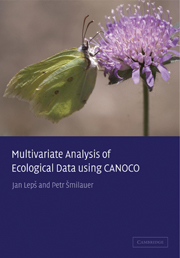Book contents
- Frontmatter
- Contents
- Preface
- 1 Introduction and data manipulation
- 2 Experimental design
- 3 Basics of gradient analysis
- 4 Using the Canoco for Windows 4.5 package
- 5 Constrained ordination and permutation tests
- 6 Similarity measures
- 7 Classification methods
- 8 Regression methods
- 9 Advanced use of ordination
- 10 Visualizing multivariate data
- 11 Case study 1: Variation in forest bird assemblages
- 12 Case study 2: Search for community composition patterns and their environmental correlates: vegetation of spring meadows
- 13 Case study 3: Separating the effects of explanatory variables
- 14 Case study 4: Evaluation of experiments in randomized complete blocks
- 15 Case study 5: Analysis of repeated observations of species composition from a factorial experiment
- 16 Case study 6: Hierarchical analysis of crayfish community variation
- 17 Case study 7: Differentiating two species and their hybrids with discriminant analysis
- Appendix A Sample datasets and projects
- Appendix B Vocabulary
- Appendix C Overview of available software
- References
- Index
15 - Case study 5: Analysis of repeated observations of species composition from a factorial experiment
Published online by Cambridge University Press: 09 February 2010
- Frontmatter
- Contents
- Preface
- 1 Introduction and data manipulation
- 2 Experimental design
- 3 Basics of gradient analysis
- 4 Using the Canoco for Windows 4.5 package
- 5 Constrained ordination and permutation tests
- 6 Similarity measures
- 7 Classification methods
- 8 Regression methods
- 9 Advanced use of ordination
- 10 Visualizing multivariate data
- 11 Case study 1: Variation in forest bird assemblages
- 12 Case study 2: Search for community composition patterns and their environmental correlates: vegetation of spring meadows
- 13 Case study 3: Separating the effects of explanatory variables
- 14 Case study 4: Evaluation of experiments in randomized complete blocks
- 15 Case study 5: Analysis of repeated observations of species composition from a factorial experiment
- 16 Case study 6: Hierarchical analysis of crayfish community variation
- 17 Case study 7: Differentiating two species and their hybrids with discriminant analysis
- Appendix A Sample datasets and projects
- Appendix B Vocabulary
- Appendix C Overview of available software
- References
- Index
Summary
Introduction
Repeated observations of experimental units are typical in many areas of ecological research. In experiments, the units (plots) are sampled first before the experimental treatment is imposed on some of them. In this way, you obtain ‘baseline’ data, i.e. data where differences between the sampling units are caused solely by random variability. After the treatment is imposed, the units are sampled once or several times to reveal the difference between the development (dynamics) of experimental and control units. This design is sometimes called replicated BACI – before after control impact. To analyse the univariate response (e.g. number of species, or total biomass) in this design, you can usually apply the repeated measurements model of ANOVA.
There are two possibilities for analysing such data. You can use the split-plot ANOVA with time, i.e. the repeated measures factor, being the ‘within plot’ factor, or you can analyse the data using MANOVA. Although the theoretical distinction between those two is complicated, the first option is usually used because it provides a stronger test. Nevertheless, it also has stronger assumptions for its validity (see e.g. Lindsey 1993;Von Ende 1993). The interaction between time and the treatment reflects the difference in the development of the units between treatments. CANOCO can analyse the repeated observations of the species composition in a way equivalent to the univariate repeated measurements ANOVA. Whereas all the model terms are tested simultaneously in ANOVA, in CANOCO you must run a separate analysis to test each of the terms.
Information
- Type
- Chapter
- Information
- Multivariate Analysis of Ecological Data using CANOCO , pp. 215 - 235Publisher: Cambridge University PressPrint publication year: 2003
